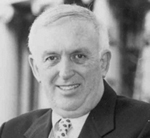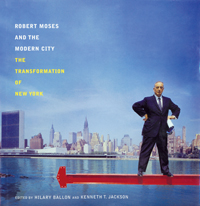|
|
 |
 |
|
BOOKSHELFBallon, Jackson Reexamine Robert Moses’ LegacyBy Maryam Parhizkar ’09
 
(Top) Hilary Ballon PHOTO: EILEEN BARROSO (Bottom) Kenneth T. Jackson PHOTO: JOE PINEIRO  Urban planner Robert Moses has been one of New York’s most controversial figures for three-quarters of a century. Since 1974, when Knopf published The Power Broker: Robert Moses and the Decline of New York, Robert Caro’s masterful and corrosive biography of the man who held various roles in city and state government from 1930–65, there has been debate about Moses’ planning methods, which Caro claimed were responsible for the fall of New York. But the critical tide may be turning. In January, “Robert Moses and the Modern City” — a revisionist exhibition organized by Hilary Ballon, professor of art history and director of art humanities — opened at three separate museums. Through a partnership involving Columbia’s Miriam and Ira D. Wallach Art Gallery, the Museum of the City of New York and the Queens Museum of Art, the large exhibition was shown in three parts: “Slum Clearance and the Superblock Solution,” “Remaking the Metropolis” and “The Road to Recreation.” To coincide with the exhibit, Ballon and Kenneth T. Jackson, the Jacques Barzun Professor in History and the Social Sciences, co-edited a new volume, Robert Moses and the Modern City: The Transformation of New York (W.W. Norton, $50). This impressive anthology is the first major book to be published on Moses since The Power Broker. A collection of photographs and essays written by scholars across the country, the book gives a gentler view of the builder who, in critic Paul Goldberger’s words, has been seen as “the evil genius of mid-twentieth-century urban design.” Ballon and Jackson argue that Moses’ public works are now indispensable parts of the New York we know. “Robert Moses had a greater impact on the physical character of New York City than any other individual,” Ballon and Jackson point out in their introduction, “and given how the process of city building has changed since his time, it is unlikely that anyone in the future will match him.” 


Moses modernized New York City’s face with $27 billion in public works (according to Caro), including a network of bridges, expressways and parkways, two World’s Fairs, Shea Stadium, Lincoln Center and the United Nations headquarters, as well as parks and swimming pools. “The prevailing view of Moses is that he had no overarching urban public purpose,” Ballon writes, countering critics such as Caro and Jeanne R. Lowe, as she defends Moses’ Title I development plans for the city. Instead, Ballon suggests, “Moses shaped Title I … to keep New York the thriving center of a spreading metropolitan region and a magnet for suburbanites, the U.S., and the world.” The remainder of the book continues this revisionist examination of Moses’ impact, while responding to the more critical arguments that scholars have made, particularly regarding the deterioration the metropolis suffered from 1950–75. “[Since 1975, New York] changed from a poster child of urban despair to an international symbol of glamour, sophistication, success, competition, and safety,” Jackson argues. Like the exhibitions it accompanied, Ballon and Jackson’s book is a detailed study of Moses’ career — a series of superhuman achievements which, they claim, were ultimately more responsible for New York’s rise than its fall.
|
|
||||||||||||||||||||||||||||